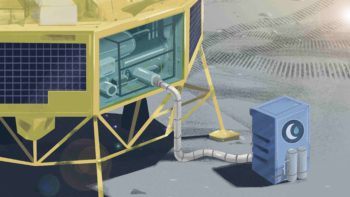







The Aqualunar Challenge is calling innovators to create innovative technologies for use on the Moon to remove contaminants found in lunar water.
These technologies may also contribute to novel water purification technologies here on Earth.
Whether you are a start-up or a team of scientists, academics, engineers or problem solvers – we need your ideas – whether you have worked in the space sector previously or not. Find out more in our Applicant guide.
This 17-month challenge prize is your opportunity to make your mark on space tech and the future of exploration.
We offer a series of financial and non-financial awards to the teams developing the best water purification technologies suitable for use on the lunar surface.
During the Aqualunar Challenge, teams won’t be going to the Moon: you will be creating concepts and then designs of water purification technologies.
During the Challenge, teams will not develop a technology that is ready to meet all the constraints of a real life lunar mission. But we’re looking for a clear path to get there, and a design that takes our objectives into account.
With humankind returning to the Moon later this decade, purifying the water that exists on the Moon in ice is critical to enabling more ambitious space missions. Using lunar water – as drinking water, to grow food, to create oxygen and to split into hydrogen and oxygen for rocket fuel – is a key enabler for supporting future deep space exploration.
Data suggests that large quantities of water may exist in permanently shadowed regions near the lunar south pole.
But this water is not pure, with a number of contaminants preventing its use unless it is purified.
And purifying that water in the Moon’s harsh environment – at low temperatures, using minimal power, and without easy human access – is tough.
As well as having applications for exploration of the Moon and beyond, technologies developed in the Aqualunar Challenge will have wide application here on Earth – wherever lightweight, robust, low-power water purification is needed.

The Aqualunar Challenge mission scenario sets out in further detail what we mean by purifying water on the moon: teams should design with this mission in mind.
Your team’s technology has been ferried to the Moon onboard an uncrewed spacecraft and has touched down near the rim of Shackleton Crater, near the Lunar South Pole.
Inside the crater, buried in the regolith (soil) is ice.
There’s a large regolith extraction area in the permanently shadowed area of Shackleton Crater. A separate subsystem is then doing an initial processing of the regolith, leaving dirty ice.
This is primarily frozen H2O, but it also contains varying levels of hydrogen sulfide (H2S), ammonia (NH3), carbon monoxide (CO), ethylene (C2H4), sulfur dioxide (SO2), methanol (CH3OH), and methane (CH4), plus traces of solid regolith.
You can assume that you are located next to this processing operation, or a short distance away from a permanently shadowed area if your process requires it.
Your technology must take this dirty ice and reliably produce at least one litre per hour of clean drinking water.
The Lunar conditions you need to take into account include:
In addition, you need to take into account the technical constraints of a lunar lander, including: